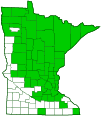tamarack
(Larix laricina)
Conservation • Wetland • Description • Habitat • Ecology • Use • Distribution • Taxonomy
Description |
||
Tamarack is the only deciduous conifer native to Minnesota. It is fast-growing and short-lived, usually no more than 150 years old. It rises on a single trunk from shallow, spreading roots. In Minnesota mature trees are usually 40′ to 70′ tall and 14″ to 20″ in diameter at breast height. Large individuals can be 100′ to 115′ tall, 36″ to 42″ in diameter, and 230 to 240 years old. The crown on young trees is narrow, cone-shaped, and open. On older trees the crown becomes irregular. The trunk is slender and straight and extends to the top of the tree. The bark on young trees is smooth and gray. On mature trees the bark is rough, reddish-brown, thin, and flaky, with small scales. There are 2 types of branches. Branches of the current year are long and have scattered, single leaves. Branches of prior years develop lateral, dwarf, secondary branches. These secondary branches are slow-growing and produce crowded clusters of many leaves. Principal branches are horizontal or sometimes slightly ascending. The twigs are orangish-brown and hairless. The buds are dark red, hairless, and subtended by a ring of hair-like bracts. The needle-like leaves are soft, pointed, slender, ¾″ to 1½″ long, and deciduous. They are flat on top and keeled below, 3-sided in cross section. They are bright green in the spring, bluish green in the summer, and turn dull yellow and fall off in September or October. They are borne in a tight spiral of 12 to 30 needles on a short, wart-like, spur branch. On terminal shoots they also appear singly. In winter tamarack can be identified by the distinctive spur branches. Male and female cones are borne on the same tree. Pollen (male) cones are spherical and yellow. They are borne singly on 1- or 2-year-old branchlets. Female cones at the time of pollination are almost spherical and red. They are borne singly, mostly on 2- or 4-year-old branchlets, but also on 5- to 10-year-old or older branchlets. On young trees they appear on 1-year-old branchlets. They appear in all parts of the crown. Pollination takes place in late April or early May. Male cones shed pollen then wither and fall away. Female seed cones mature mid-August to September. Mature seed cones are light brown, woody, egg-shaped, symmetrical, and ⅜″ to ¾″ long. They are on short, stout, curved stalks. They are covered with 10 to 30, but usually 12 to 15, scales. Mature scales are smooth and rounded at the tip. There are 2 seeds in each fertile scale. The seeds are 1 ⁄16″ to 3 ⁄32″ long, with a ⅛″ to ¼″ long, chestnut-brown wing. Most seeds are shed in the first 3 weeks of September, with the remainder being shed by the end of October. |
||
Height |
||
40′ to 70′ |
||
Record |
||
There is no current (2021) champion tamarack in Minnesota. |
||
Similar Species |
||
The clusters of 12 to 30 needles on short, wart-like, spur branches, and the needles that turn yellow and fall off in the fall, distinguish larches (Larix spp.) from all other needle-bearing trees in Minnesota. European larch (Larix decidua) is a larger, sometimes much larger tree. The twigs are pale yellow. Needles are borne singly or in clusters of 30 to 40. Mature seed cones are ¾″ to 1¾″ long and are covered with 40 to 60 scales. It is rare in Minnesota. |
||
Habitat |
||
Wet, poorly drained sites, swamps, bogs, muskeg. Shade intolerant. |
||
Ecology |
||
Pollination |
||
Late April to late May |
||
Pests and Diseases |
||
Larch canker |
||
Use |
||
|
||
Distribution |
||||
|
Sources |
|||
| 4/14/2023 | ||||
Nativity |
||||
Native |
||||
Occurrence |
||||
Common |
||||
Taxonomy |
|||
| Kingdom | Plantae (Plants) | ||
| Division | Tracheophyta (Vascular Plants) | ||
| Subdivision | Spermatophytina (Seed Plants) | ||
| Class | Pinopsida (conifers) | ||
| Subclass | Pinidae | ||
Order |
Pinales (conifers) | ||
Family |
Pinaceae (pine) | ||
| Subfamily | Pinoideae (pines, spruces, larches, and allies) | ||
Genus |
Larix (larches) | ||
Subordinate Taxa |
|||
|
|||
Synonyms |
|||
Larix alaskensis Larix laricina var. alaskensis Pinus laricina |
|||
Common Names |
|||
Alaskan larch American larch black larch eastern larch eastern tamarack hackmatack red larch tamarack |
|||
Glossary
Keeled
Folded, as in a grass blade, or with a raised ridge, as in a grass sheath; like the keel of a boat.
Wing
A thin, flat, membranous, usually transparent appendage on the margin of a structure.
Visitor Photos |
|||||
Share your photo of this plant. |
|||||
| This button not working for you? Simply email us at info@MinnesotaSeasons.com. Attach one or more photos and, if you like, a caption. |
|||||
Luciearl |
|||||
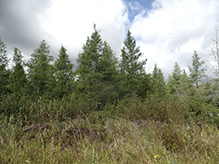 |
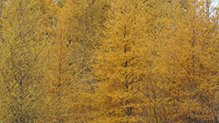 |
||||
Randy |
|||||
An old American Larch, definitely not a European Larch, growing in a yard in Albert Lea, MN |
|||||
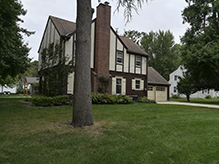 |
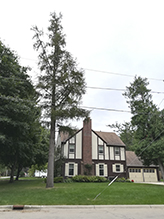 |
||||
Tamarack sapling, Freeborn County, MN, September 2017 |
|||||
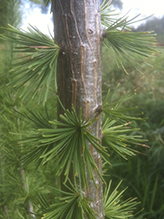 |
|||||
Tamarack, fall 2016 |
|||||
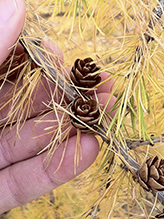 |
|||||
Tamarack west of Faribault |
|||||
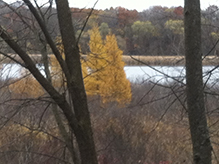 |
|||||
| Stand of wild growing tamarack, exhibiting golden yellow fall color, along the southern edge of the natural of the species, in marshland west of Faribault, MN, October 2016 | 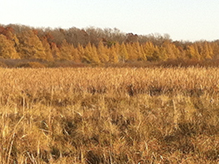 |
||||
MinnesotaSeasons.com Photos |
|||||
Tree |
|||||
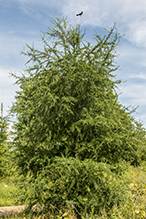 |
|||||
Branch |
|||||
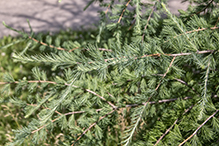 |
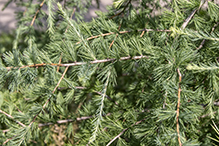 |
||||
Cone |
|||||
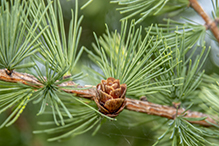 |
|||||
Early Spring |
|||||
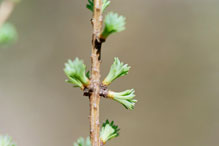 |
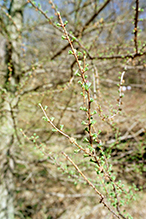 |
||||

Slideshows |
||

Visitor Videos |
|||
Share your video of this plant. |
|||
| This button not working for you? Simply email us at info@MinnesotaSeasons.com. Attach a video, a YouTube link, or a cloud storage link. |
|||
Other Videos |
|||
| Trees with Don Leopold - eastern larch or tamarack ESFNature |
|||
About
Published on Dec 18, 2013 Don Leopold demonstrates the characteristics of eastern larch or tamarack. Content produced by Christopher Baycura for the SUNY College of Environmental Science and Forestry (SUNY-ESF). |
|||
| Respect for a very old Tamarack Tree TheNorthwoodsman1 |
|||
About
Published on Mar 22, 2012 A near record age Tamarack tree fell in a Minnesota bog and it is put to good use out of respect for its longevity. Attempts to count the growth rings always end up around 325 to 350 years of age, but some of the areas are too hard to count because of the number of rings in a small space. The bog was wet enough that it did not burn when fires went through the area. |
|||

Visitor Sightings |
|||||
Report a sighting of this plant. |
|||||
| This button not working for you? Simply email us at info@MinnesotaSeasons.com. Be sure to include a location. |
|||||
| A/C Christian
Church of
Minneapolis 7/22/2023 |
Location: Westwood Hills Nature Center At the Westwood Hills Nature Center, we saw some life on July 22 this year. This was all found by the A/C Christian Church of Minneapolis. |
||||
| Luciearl 10/22/2021 |
Location: Cass County |
||||
| Luciearl 9/5/2021 |
Location: Lake Shore |
||||
| Randy Summer 2019 |
Location: Albert Lea, MN An old American Larch, definitely not a European Larch, growing in a yard in Albert Lea, MN |
||||
| Randy September, 2017 |
Location: Freeborn County, MN Tamarack sapling |
||||
| Randy October, 2016 |
Location: Rice County, MN |
||||
| Randy October, 2016 |
Location: West of Faribault, MN Stand of wild growing tamarack, exhibiting golden yellow fall color, along the southern edge of the natural of the species, in marshland |
||||
MinnesotaSeasons.com Sightings |
|||||

|
Created: Last Updated: © MinnesotaSeasons.com. All rights reserved. |
